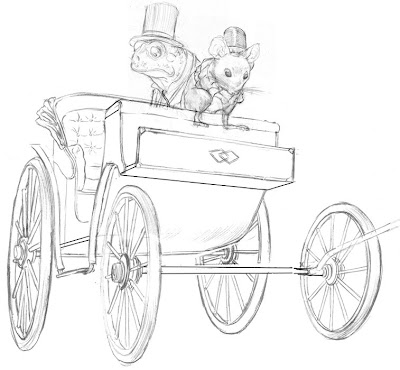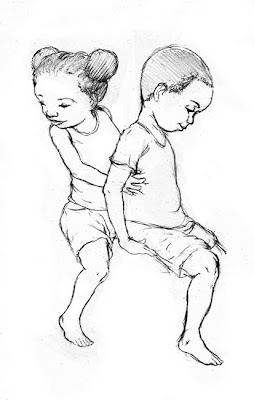Gearing up for the California North/Central Society of Children's Book Writers and Illustrators conference this weekend, and thought I'd finish out the second of these two, so that I'll have another YA piece to show off, depending on how it turns out, of course. This is meant to be a more whimsical piece than the previous one, with more elements of cartooning than strict realistic rendering.
The Advantages and Disadvantages of Teaching One-On-One
I've recently been teaching my student, Henry, glazing techniques in acrylic, and am surprised to find that even after not having painted in glazes in over 9 years, I've learned quite a bit about painting in the meantime just from looking at paintings, and I suppose, from rendering my ink drawings in color, even though the method is quite a bit different. In this way I'm able to save him from a lot of my own former bad habits, not the least of which was a tendency to use entirely too much thalo blue.
It's such a pleasure to be able to pass on what knowledge I have and to teach someone something practical. In my own school years we were expected to figure out quite a bit about painting on our own, and no one really taught me how to glaze properly. Most of what was taught was opaque rendering, and my own discovery of glazes was something I had to fumble through on my own.
In teaching one-on-one as I've been doing in the last two years, it's easy to impose all your best and worst tendencies on your pupil, and frustrating when you see your own deficits appear in them. I've tried to compensate for this somewhat by offering when I can, supplementary material, such as video anatomy lessons. Right now he doesn't have the benefit of a fully rounded body of course work, so I do what I can. He's just about to turn 16, so when he goes to college he'll get more of that, but I'd like to prepare him as much as possible. My goal is to give a strong foundation in drawing, ink rendering and painting, and eventually, offer him a little bit of figure drawing experience from the model when I introduce him to our figure drawing sessions when he's a little older.
He's a sharp kid, and it's a great benefit to have someone motivated and passionate to teach. I imagine it's frustrating when you don't have that advantage. Most of my teaching experience involves younger kids without much drawing background, so it's a pleasure to see his skills develop. I've been building his skills starting with contour and gesture drawing, working up to full tonal rendering, and what is often neglected in drawing classes, deliberate and comprehensive attention to craft. I've been trying to teach him how important it is to pay attention to every aspect of the drawing or painting, making sure that everything is purposeful. If there are any accidents, they're happy accidents that he's allowed and considered, rather than simply mistakes.
At the same time I've been trying to help him develop hand skills, and before we even touched paint, I had him learn control with the brush, until he could feather and do fairly precise line work with brush and ink. We've also introduced a little bit of crow quill and cross hatching techniques.
He has an enthusiasm for comics, which I've encouraged, and I try to send him home every week with something a little different from my own collection. He's done some of his own comics that I've guided him through, using them as a vehicle to develop his hand skills and ability with ink. I think this has been important, especially at his age, because it helps keep him focused and interested when he's not strictly working academically. Hopefully he's also developed a nice sketchbook habit, but that's something I've allowed for him to maintain privately. This way, he doesn't consider the sketchbook homework, but something he does for pleasure, or at least that's the idea.
I've also tried to help him develop a knowledge of a little art history, with a focus on modernism, which again, is my own bias. I'm not teaching him art history in the strictest sense, but simply introducing different artists relevant to what we're doing, or that I think will intrigue him. In college he'll get more of a comprehensive art history education, but it's good, I think, now, to familiarize him with a few interesting painters. We've gone over the impressionists and post impressionists primarily, but I hope to introduce him to other artists as we move along. Today, for instance, we'll be meeting at the library to look at a number of painters so we can talk about some of the techniques that they use that we've discussed.
Ultimately my hope is to give him a kick-ass advantage before he hits college, and if I do my job, he'll have a real primer in art fundamentals that I never had, and his beginning course work will seem more like review, sort of like what high school offers in other areas of academics. Art, unfortunately, isn't often taught, or considered this way, and it's often the job of a good university or art school to give students a crash course in what they would have better benefited to have learned earlier on. That is, if they have the benefit of an school with a strong foundation in fundamentals, which is a little more rare than it should be.
Punctuated Equilibrium
It's been a pleasure so far, especially watching him hit those little marks of improvement along the way. It's fun to see this build up of knowledge result in these periods of what I like to call, "punctuated equilibrium." Just like the term in evolution, I use this in reference to those moments of big change after long periods of little changes or improvements. In evolution the word "adaptability" would be more accurate than "improvement" since improvement is a relative concept that relates more directly to what we're trying to achieve in teaching, but I still think "punctuated equilibrium" is an apt way to describe these little epiphanies that occur every once in a while when all the pieces click together. These moments can be the most satisfying in teaching, when you really feel like you're effective in what you're doing.
He seems to have set his sights on going to art school, but what he ultimately decides to pursue, of course, will be up to him. He may end up being a performance artist or an abstract painter, but if all goes well I'll feel content that I've been able to give him a strong foundation that he might not otherwise have had.























